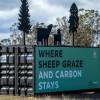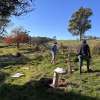
Final Report now available: Assessing the efficiency of mechanised hardwood thinning operations
Posted 07 March 2024
Managing trees Economic benefits and markets Native regrowth forest management PFT Tree Alliance
Tasmania, along with the broader Australia, currently faces a significant wood supply shortage, particularly in the building and construction sector.
In response, Tasmania has taken substantial steps to identify industry and community-supported priorities for addressing the urgent need for additional wood. Private Forest Tasmania (PFT) collaborated with Forico Pty Limited (“Forico”) to investigate costs and silvicultural practices, focusing on efficiently transitioning from short (pulpwood-focused) to longer (solid wood/sawlog or engineered wood-focused) rotations.
The goal is to promote stand improvement strategies within Tasmania's existing plantation resources, ultimately enhancing domestic sawlog supply outcomes in the short to medium term.
The transition from pulp to solid wood plantation regimes in Tasmania requires a comprehensive understanding of the costs associated with thinning operations and the factors influencing the productivity and costs of mechanised equipment in these conditions.
This project utilises machine productivity data to assess mechanised thinning operations in Eucalyptus nitens stands, pinpointing the key factors affecting productivity and costs. Additionally, sensing technology, including mobile LiDAR systems, has been employed to evaluate the quality features of the remaining trees, such as Diameter at Breast Height (DBH), height, branchiness, tree form, and stem damage.
The results of the machine study reveal that over 85% of the variability in thinning productivity can be attributed to stem volume. Additional variability is explained by the location of the removed trees during thinning (outrows or outer rows).
Thinning productivity was higher across the range of stem volumes when the operator decided which trees to remove.
This difference was more pronounced with larger stem volumes compared to the treatment involving tree marking before thinning.
In contrast to the plot with marked trees, the Diameter at Breast Height (DBH) and stem volume of trees selected by the machine operator were consistently higher, irrespective of the location of the removed trees (whether in adjacent or outer rows), except for trees removed from outrows.
This finding is crucial for understanding the higher productivity observed in the operator selection plot compared to the plot where trees were marked beforehand.
In addition to providing insights about machine productivity, the study implemented and validated a methodology for scanning trees before and after thinning to optimise data capture in terms of time and accuracy.
This approach facilitated a detailed capture of tree features, including diameter and height, for subsequent processing with automated algorithms and tools.
Despite the absence of reference or control points on the ground, the tree detection rate was notably high, averaging over 90% for both plots.
The trajectory line was the sole criterion used for tree detection within the plots. Notably, this difference is relatively low, considering the challenging conditions in Eucalyptus nitens plots, which are characterised by loose bark, branches, and high understory vegetation on the lower part of the stems.
These factors pose challenges in accurately estimating diameter from point cloud data collected with the Lidar sensor and processed with automated algorithms.
This study reaffirms the invaluable role of LiDAR technology in informed decision-making during thinning operations.
Lidar point cloud data collected before thinning empower harvest planners to make well-informed decisions regarding the optimal location of thinning roads, tree selection during thinning, and alternative thinning strategies before field implementation.
Real-time or pre-thinning Lidar data also aids harvester operators in making optimal tree selection decisions, incorporating variables like tree density for removal decisions and other factors such as basal area, tree form, and branchiness.
These considerations would be challenging to capture without the assistance of LiDAR technology.
The insights gained from this project are expected to provide valuable information for enhancing the cost-effectiveness of mechanised thinning operations in Tasmania and the broader context of Australia.






